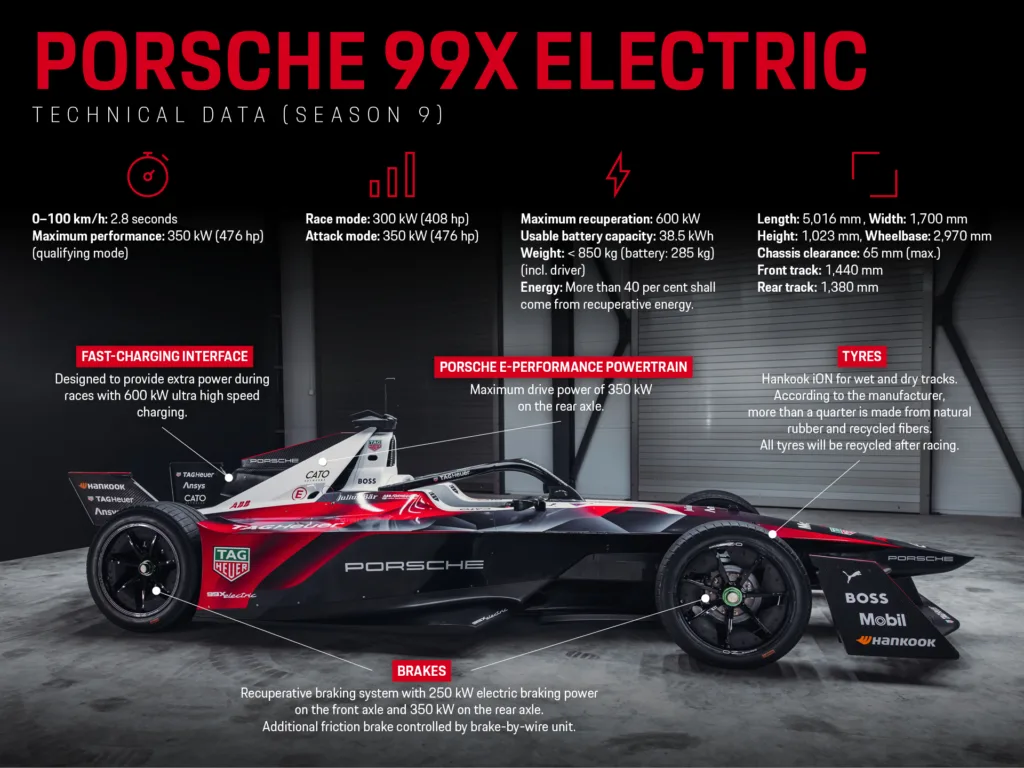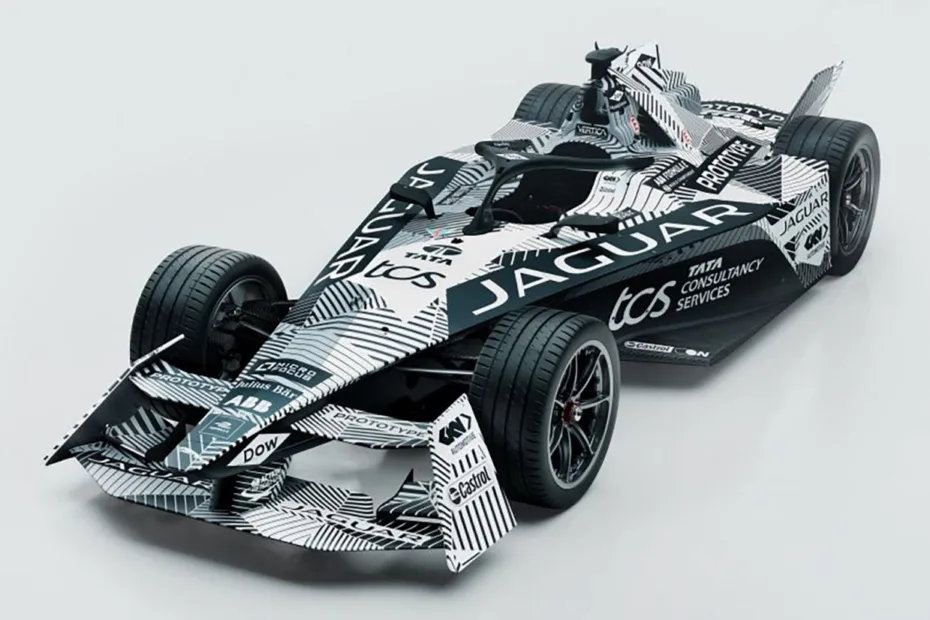Formula E has come a long way in less than 10 seasons. They strode through two astronomical leaps in electric car performance and drove the revolution with the leap from GEN1 to GEN2 and on to the world’s fastest, lightest, most sustainable electric race car ever: the GEN3.
So, how fast is the Formula E GEN3 car? How big is its battery and how does the GEN3 Formula E car perform?
Formula E’s Cutting Edge Electric Race Car, GEN3, Explained, as published by the FIA ABB Formula on www.fiaformulae.com
While the ABB FIA Formula E World Championship approaches Season 10 and the opening race in Mexico City, the on-track technology is ever-evolving and has undergone revolutionary changes in those nine years.
How much power and how big was the battery in Formula E GEN1, and how fast could it go?
In Season 1, back in 2014, Formula E ushered in a revolution with the all-electric open-wheel GEN1 car – a first of its kind in motorsport. In the nine short years since they waved goodbye to that initial era of mid-race car swaps and welcomed the next step-change in technology for Formula E with GEN2 in Season 5. More power and almost twice the usable energy capacity, effectively doubling range despite its battery being about the same size and weight as its predecessor.
From GEN1 to GEN2, as well as a huge jump in energy capacity, pace and performance kicked on a notch, too. Power output jumped from 150kW to 200kW in race trim between Season 1 and Season 7, with ATTACK MODE yielding a further 10kW and qualifying mode boosting power to 250kW. This shaved 0.2 seconds off the 0-100km/h sprint, which was reduced to 2.8 seconds – pushing top speed up to 280km/h (174mph) from 225km/h (140mph).
For Season 8 and GEN2’s swansong, power was increased to a baseline 220kW with ATTACK MODE hitting the maximum output of our second era at 250kW or 335bhp.
| GEN1 | GEN2 | GEN3 | |
|---|---|---|---|
| Overall length | 5000mm | 5200mm | 5016.2mm |
| Overall height | 1050mm | 1063.5mm | 1023.4mm |
| Overall width | 1780mm | 1800mm | 1700mm |
| Wheelbase | 3100mm | 3100mm | 2970.5mm |
| Minimum weight (incl. driver) | 900kg | 900kg | 840kg |
| Maximum power | 200kW (270bhp) | 250kW (335bhp) | 350kW (470bhp) |
| Maximum regeneration | 150kW | 250kW | 600kW |
| Energy recovery | Approx 15% | Approx 25% | Over 40% |
| Top speed | 225kmh/ 140mph | 280kmh / 174mph | 320kmh / 200mph |
| Powertrain | Rear only | Rear only | Front & rear |

The GEN3 revolution: faster, lighter, and more sustainable
Season 9 saw Formula E’s third great leap and the GEN3 era, with the all-new GEN3 car, previewed and launched at the 2022 Monaco E-Prix, hitting the track for the first time in Valencia, at testing, that same year.
The 2022/23 campaign saw the culmination of eight years of world-class electric racing and everything learned by Formula E’s teams and engineers hit the track – it’s the pinnacle and intersection of high performance, efficiency, and sustainability. The new GEN3 is lighter, smaller, faster, and more sustainable than what came before, and incorporates several cutting-edge features set to inspire and inform major automotive manufacturers into their next moves in the consumer car market while showing there need not be compromise in an electric racing car.
It’s also the most efficient race car on the planet, with some 40% of the energy it expends recaptured for use through the rear and a new front powertrain, for up to 600kW total energy regeneration. So, that’s not only a leap in power of almost 1.5x – bringing about a 0-100kmh sprint of around two seconds – but a near-doubling of regen capacity.

Every aspect of GEN3 production has been rethought, redesigned, and rebuilt to ensure the car sets the benchmark for high-performance, sustainable racing without compromise, while all suppliers must complete a life-cycle assessment of their products. For example, natural materials have been introduced to tires, batteries, and bodywork construction with life-cycle thinking at the core.
Early evolution: The fastest electric race car in the world
Before the leap to GEN3 and even GEN2, GEN1 itself saw a number of changes. In Season 2, the regulations were opened up to allow manufacturers to design their own motors, inverters, gearboxes, and rear suspension, with power also bumped to 170kW (230bhp).
For Season 3, a mid-life refresh for GEN1 introduced a redesigned and stronger front wing to better cope with the rigorous street racing, whilst regen saw a 50 percent improvement in efficiency thanks to a major battery technology upgrade – all while reducing the car’s overall minimum weight by eight kilos.

GEN1’s swansong came in Season 4 with GEN2 on the horizon, but we still saw another 10kW bump to overall power. Then came GEN2 with its raft of changes and the ability to run a full race on a charge, and far faster than its predecessor. Safety improvements were built into the new car in the form of the FIA-mandated halo device and ATTACK MODE added an extra layer for drivers and race engineers to get their heads around – with a risk/reward power boost to incorporate into race strategies.
ATTACK MODE was made more potent in Season 6, being raised from 225kW to 235kW, with regen now so efficient that the FIA mandated a 1kWh reduction in usable energy for every lap spent under the BMW i Safety Car or full course yellow – meaning energy management would always remain a key component to any race-winning drive.
Every step of the way from GEN1, GEN2 to GEN3: Brazilian Lucas di Grassi, Season 3 champion
Lucas di Grassi has been with Formula E since day zero, pre-Season 1, in fact, and was there throughout the championship’s formative moments before we got underway in 2014/15.
At that time, creating an all-electric open-wheel championship of the scope of Formula E was a tough ask. Nothing of its kind had been attempted before and the technology, though available, was very much in its infancy.
The 2016/17 champion said it was a case of using what was sure to work, before opening up the platform for manufacturers to tinker and develop – driving the race-track to road philosophy that is at Formula E’s heart, as the series pushes clean, sustainable mobility forward – with what would take five years in the automotive sector taking just one in Formula E.
“The GEN1 car had to use technology that would be capable, as nobody had produced an electric racing car like it before,” said the Brazilian. “So, it was relatively simple – pretty basic in fact – but with scope for teams to make improvements and develop things.
“As soon as the technical restraints were opened up (from Season 2), you saw performance and efficiency improvements right away. A five-year development programme in the real world, aiming to create a 10 per cent efficiency saving from the motors, was completed in just a year of competition in Formula E.

“By Season 4, we had the big step coming with GEN2. By then, people had learned best practices – what was right and what didn’t work quite so well – so a leap forward was possible. Moving from two cars to a single car was huge.
“As technology develops, electric cars will be able to go faster and further. The pace of development is incredible,” adds di Grassi. “The point at which electric cars are cheaper, safer and easier to operate than combustion-engined cars is not far away at all and Formula E is accelerating that process. Combustion won’t be able to keep up.
“The purpose is to create a better, cleaner, safer future for mankind with innovation and technology. In general, people will naturally go for convenience and necessity, as well as the cheapest, best solution for them. So, we need to create technology that fills this gap and serves this purpose, then, the best option will be the most sustainable one – that’s the win-win situation to chase.”
GEN3 and the Guinness World Record-breaking future: GENBETA
We’ve already seen Formula E records tumble in Season 9 – even as teams are only beginning to scratch the surface of what’s possible with the all-new equipment they have at hand. To flesh out that point, we didn’t see GEN2 peak until the very last season it hit the track – some four years after its introduction.
Nissan’s Sacha Fenestraz became the fastest man in Formula E with laps in Cape Town and Portland – both debut entries on the calendar. Season 9 champion Jake Dennis then took the honor of fastest over a lap with his Duels time in Oregon. That same weekend, we also saw Mitch Evans set the series’ highest-ever top speed.
There’s far more to come, though.
“GEN3 brings a host of innovations, but we’re still committed to going a step beyond. We’re already thinking of the evolution we can bring through the four-year cycle,” said FIA Technical Manager and GEN3 Project Lead Alessandra Ciliberti after the GEN3 launch in Monaco, 2022.
“We’re investigating using the front powertrain kit in traction as well as regen to allow for four-wheel drive-in specific scenarios and then looking even further to GEN4 we have to ensure Formula E remains at the forefront as the laboratory for future mobility. We will work through and understand the challenges the manufacturers face from a technical perspective to make sure it remains the perfect platform for them.”
As it happens, we have just seen the first use of the front powertrain in traction – offering a tantalizing glimpse of what’s to come next with four-wheel drive and an extra 50kW of power, via GENBETA’s Guinness World Record-smashing effort in London.
The GENBETA car featured a range of modifications to effectively ‘unlock’ the specifications of the GEN3 race car:
- Enhanced battery power output of 400kW, up from 350kW in the GEN3, through the activation of the front powertrain kit in traction, delivering all-wheel drive for the first time in a Formula E car. The battery was charged by ABB, the title partner and official charging partner of the Championship
- The new, softer iON Race tire compound allows faster warm-up and better peak grip, developed by Hankook Tire, the official tire supplier of Formula E
- 3D printed front wing endplates, wheel fins, and a wind deflector with circular, more sustainable thermoplastic solutions developed by SABIC, principal partner of the ABB FIA Formula E World Championship, to optimize aerodynamics for enhanced straight-line speed of the GENBETA
In addition to technology innovations on the GENBETA car, Google Cloud provided generative artificial intelligence (AI) for analysis of the drivers’ runs. Using their leading platform, Vertex AI, drivers Jake Hughes and Lucas di Grassi were able to interpret real-time telemetry data to generate speed, power and grip recommendations. This gave them the ability to interact and converse with an interface to help fine tune their approach across their three attempts.
GENBETA will break cover with one of the most decorated Olympians of all time behind the wheel in Mexico City. Keep your eyes on fiaformulae.com and @FIAFormulaE for more…!
This article was published by FIA Formulae on January 2024.
